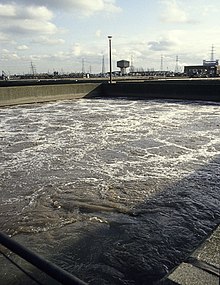Beckton Sewage Treatment Works

Beckton Sewage Treatment Works is a sewage treatment plant in Beckton in the London Borough of Newham, East London. It was formerly known as Barking Sewage Works. It was built from 1864 and, now operated by Thames Water, it is one of the largest sewage works in the United Kingdom. It treats the waste water from the Northern Outfall Sewer serving North and East London. The plant has been extended and upgraded several times, most recently in 2011–13, and now covers 55 hectares (140 acres).
History
Sewage treatment works were first established in 1864 as part of Joseph Bazalgette's scheme to remove sewage (and hence reduce disease) from London by creating two large sewers from the capital, one on each side of the Thames and known as the Southern and Northern Outfall Sewers. The Beckton sewage works (TQ448823), at the end of the northern outfall sewer, is Europe's 7th largest and is now managed by Thames Water. In addition to the sewage from the Northern Outfall sewer the Becton treatment works also received sewage from a pumping station at North Woolwich.[1][2]
As originally conceived in 1864 the works comprised reservoirs covering 3.8 hectares designed to retain six hours’ flow of sewage. No sewage treatment was provided and the sewage was discharged on the ebb tide.[3] The presence of raw sewage contributed to the high death toll in the 1878 Princess Alice disaster, when over 600 died in Britain's worst inshore shipping tragedy. Following the disaster a Royal Commission was appointed in 1882 to examine Metropolitan Sewage Disposal. It recommended that a precipitation process should be deployed to separate solids from liquid and that the solids should be burned, applied to land or dumped at sea. A precipitation works using lime and iron sulphate was installed at Beckton in 1887–89.[4] Sludge was disposed of in the Barrow Deep and later in the Black Deep in the outer Thames estuary.[5] In the year 1912/3 1,704,000 tons of sludge was sent to sea, by 1919/20 1.223 million tons of sludge were sent to sea, entailing 1,223 sludge vessel voyages.[1]
In the year 1912/13 the total volume of sewage received at Beckton was 59,067 million gallons (268 million m3).[2] In the year 1919/20 the volume was 59,667 million gallons (271 million m3).[1] The costs of treating the sewage at Beckton was £73,698 or £1 4s 11d per million gallons (£1.246 per 4546.1 m3) in 1912/13; by 1919/20 the cost had increased to £79,074 or £1 6s 6d. (£1.325) per million gallons.[2][1]
Advanced treatment
In 1932–5 an activated sludge plant was installed which relied on surface aeration of the sewage by mechanical paddles. In 1959 a £7.5 million extension (equivalent to £220,000,000 in 2023) was completed. This comprised detritus removal, a screen house, primary sedimentation tanks, a diffused air activated sludge plant and sludge digestion. The works were extended in 1967 to treat 1.14 million cubic metres per day of sewage, although they were capable of accepting a flow of 2.6 million cubic metres per day. These works cost £21 million (equivalent to £481,000,000 in 2023).[6]
The Beckton plant comprised:[6]
| Treatment tanks at Beckton sewage treatment works, 1967 | ||
|---|---|---|
| Service | No. | Type |
| Primary sedimentation | 32 | Rectangular |
| Aeration tanks | 14 | Rectangular |
| Final sedimentation tanks | 72 | Circular |
| Sludge digestion tanks | 36 | Circular |
The treated effluent outfall from the plant is into the river Thames at the south-east corner of the works adjacent to Barking creek. Sewage sludge was disposed of by dumping at sea in the outer Thames estuary. This practice of dumping sewage sludge at sea was banned in 1998. In that year a sludge incineration plant was commissioned.[7] This provides 11.4 MW of power for use at the treatment works.
New processes
In 2014 an upgrade to the Beckton works included a new activated sludge process stream designed to treat 30 per cent of the 27 cubic metres per second maximum flow to the works; three new odour control plants installed across the existing works to address planning conditions imposed on the upgrade project; replacement of 48 existing final settlement tank scrapers; and upgrades to a further 24 final settlement tanks.[8]
The site was mooted in 2005 as the location for a desalination plant, but the proposal was rejected by Mayor Ken Livingstone as environmentally unacceptable. The scheme has been resurrected by the successive mayor, Boris Johnson, as part of a deal with Thames Water to reduce delays in fixing roadworks throughout London. The sewerage works has been expanded to handle the flow from the Thames Tideway Scheme.
See also
References
- ^ a b c d London County Council (1923). London Statistics 1920-21 vol. XXVII. London: London County Council. p. 99.
- ^ a b c London County Council (1915). London Statistics 1913-14 vol. XXIV. London: London County Council. p. 203.
- ^ Wood, Leslie B (1982). The Restoration of the Tidal Thames. Bristol: Adam Hilger. p. 34.
- ^ Wood, Leslie B (1982). The Restoration of the Tidal Thames. Bristol: Adam Hilger. p. 42.
- ^ Wood, Leslie B (1982). The Restoration of the Tidal Thames. Bristol: Adam Hilger. p. 62.
- ^ a b Wood, Leslie B (1982). The Restoration of the Tidal Thames. Bristol: Adam Hilger. pp. 103–5.
- ^ "Beckton Incinerator Plant". Industry About. Retrieved 15 February 2020.
{{cite web}}: CS1 maint: url-status (link) - ^ "Tamesis completes latest upgrade phase at Beckton STW". Tamesis. 7 November 2014. Retrieved 15 February 2020.
{{cite web}}: CS1 maint: url-status (link)
